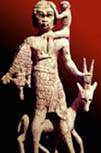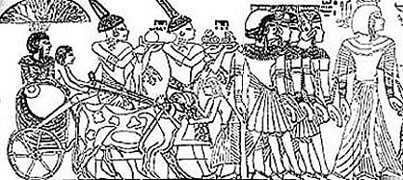Daily LifeTrade
The Kushites were the only elephant exporting people beside the Indians, as known in the ancient literature of the old world. Kushite elephants were extensively used by the ancient armies of Europe and the Near East. The Egyptian city of Elephantine, comes from the Greek word for elephant, and was named so by the Ptolemies since elephants, brought from Sudan, were sold and exported there.1
Elephant tusks were important to the economy of Kush. Thus, it is arguable that Kush was the primary exporter of ivory in the ancient world. Syria was known in the ancient world for trading with ivory imported from Sudan.2 In the fourth century BC, Herodotus wrote that the Kushites paid the Persians a tribute that included “twenty large elephant tusks” (Herodotus iii. 97).3 Gold was also a natural mineral the Kushites were known for in the ancient world. The Egyptians in the New Kingdom benefited from the conquest of Kush, mainly by excavating gold sites there. New Kingdom Egyptian paintings and relieves depict Kushites presenting gold as tribute to the Egyptian pharaohs. Wiring in the first century CE, Diodorus writes that in Meroe, "there are mines of gold, silver, iron and brass, besides abundance of ebony and all sorts of precious stones.”(Diodorus i. 33).4 It has been recorded in ancient sources that the Kushite pharaohs never applied the death sentence; convicts in Kush were rather sent to work in gold mines. In the Meroitic period, the Ptolemies and later the Romans have heavily excavated the Nubian Desert for gold.5 There are no evidence on whether the Ptolemies and the Romans paid taxes to the Kushites to excavate in the gold sites there.
During the Napatan-Meroitic period, the Kushites also exported slaves from the sub-Sahara to other regions.6 By the sixth century CE, the Kushites have exanded their trade routes with the east. Kush exported to Arabia products that included dates,7 slaves,8 dates, date-wine,9 and exotic animal leathers. Imports:One of the Kushite kingdom's most imported products was bronze. Bronze was first introduced to the Kushites by the Hyksos in the seventeenth century and was extensively used by the Kushites. The type of metal was the best available for making swords and daggers in the ancient world. Oil was also a commonly imported products by Kush. The Kushites extensively imported olive oil from Lebanon—via Arabia across the Red Sea and Egypt. Strabo, a first century CE Roman historian and geographer, wrote: “The Aethiopians (Nubians) live on millet and barley, from which they also make a drink; but instead of olive-oil they have butter and tallow”(Strabo xvii Ch. 2: 2)10 Cedar trees and lumber were also imported from the Levant and used as building materials. Temples and royal buildings in Sudan were mostly roofed with cedar trees. The Amon temple at Kawa for example was roofed by cedars that Taharqa has imported especially from Lebanon as recorded on his stele at Jebel Barkal (Sudan).11 The items also include highly valued acacia wood, which was imported from either Phoenicia or a nearby location in the Levant .
Edited: Jan. 2009. |



